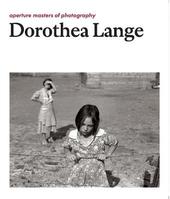
|
Dorothea Lange: Aperture Masters of Photography
Hardback
Main Details
| Title |
Dorothea Lange: Aperture Masters of Photography
|
| Authors and Contributors |
By (author) Dorothea Lange
|
| Series | Masters of Photography |
|---|
| Physical Properties |
| Format:Hardback | | Pages:96 | | Dimensions(mm): Height 203,Width 203 |
|
| Category/Genre | Individual photographers |
|---|
| ISBN/Barcode |
9781597112956
|
| Classifications | Dewey:779.092 |
|---|
| Audience | |
|---|
| Illustrations |
Illustrated in duotone throughout
|
|
Publishing Details |
| Publisher |
Aperture
|
| Imprint |
Aperture
|
| Publication Date |
3 November 2014 |
| Publication Country |
United States
|
Description
Dorothea Lange (1895-1965) documented rural poverty for the federal Resettlement Administration and Farm Security Administration from 1935 to 1939. Her powerful images--from migrant workers in California fleeing the "dustbowl," to struggling Southern sharecroppers-- became icons of the era. She later photographed Japanese Americans in internment camps during World War II and traveled throughout Europe and Asia. This book presents 42 of the greatest images from throughout Lange's career, including some of her work done abroad. She possessed the ability, as she put it, to photograph "things as they are" and through this her photographs give us "more about the subjects than just the faces." It is no wonder that Edward Steichen called her the greatest documentary photographer in the United States. Linda Gordon contributes a new biographical essay and an image-by-image commentary to accompany a newly selected set of photographs. A professor of humanities and history at New York University, she has written at length on Dorothea Lange. Her 2009 book, "Dorothea Lange: A Life Beyond Limits," won the Bancroft Prize. "Lange's work defines an era of destitution and drought, and still resonates even now. This is the perfect introduction to one of the world's greatest photojournalists."--"Practical Photography, "from a review of the original edition.
Author Biography
Dorothea Lange is best-known for the photographs she made in the 1930s when she began her pioneering work for the Farm Security Administration. From her documentation of California's migratory workers who fled dust and drought on the Great Plains and in the Southwest to seek a new life in the West, to her telling images of the desperate conditions of the sharecroppers of the South, she sought to portray the social turmoil and injustice caused by the economic upheaval of the time. During World War II, Lange photographed Japanese Americans in internment camps, documented the struggles of women and minority workers in wartime industries at California shipyards, and captured the founding of the United Nations. She later traveled and photographed throughout Europe, the Middle East, and Asia. In 1941, she received a John Simon Guggenheim Memorial Foundation Fellowship. Dorothea Lange is best-known for the photographs she made in the 1930s when she began her pioneering work for the Farm Security Administration. From her documentation of California's migratory workers who fled dust and drought on the Great Plains and in the Southwest to seek a new life in the West, to her telling images of the desperate conditions of the sharecroppers of the South, she sought to portray the social turmoil and injustice caused by the economic upheaval of the time. During World War II, Lange photographed Japanese Americans in internment camps, documented the struggles of women and minority workers in wartime industries at California shipyards, and captured the founding of the United Nations. She later traveled and photographed throughout Europe, the Middle East, and Asia. In 1941, she received a John Simon Guggenheim Memorial Foundation Fellowship. Linda Gordon is a professor of humanities and history at New York University. For the first part of her career, she wrote about the historical roots of social policy debates in the U.S., publishing several prize-winning books, including Woman's Body, Woman's Right: The History of Birth Control in America (1976). She has written at length on Dorothea Lange, including Impounded: Dorothea Lange and the Censored Images of Japanese American Internment (with Gary Okihoro, 2006), based on a group of never-published photographs of the internment of Japanese Americans during World War II that Gordon discovered, as well as the Bancroft Prize-winning book Dorothea Lange: A Life Beyond Limits (2009).
|